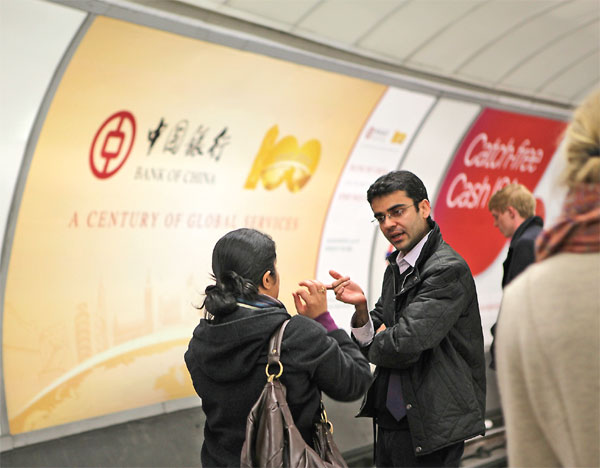BOC leads international charge
Updated: 2012-07-13 11:22
By Wang Xiaotian (China Daily)
|
|||||||||||
Major Chinese commercial lender seeks opportunities on both sides of the Atlantic, Wang Xiaotian reports.
 |
|
Bank of China has posted advertisements in prominent places in London's subway system. Diao Ying / China Daily |
Bank of China Ltd, one of China's four biggest commercial lenders by market value, is eyeing huge business potential brought about by Chinese enterprises going abroad to explore overseas markets.
"Commercial lenders are facing great business opportunities as the projects of enterprises that go abroad are becoming increasingly diversified. We will play a significant role in China's economy and cater to the demands of domestic clients, at the same time establishing a large international banking group to carry forward cross-border advantages," said Xiao Gang, board chairman of BOC.
Board members have made overseas business a strategic priority, and the lender is expected to become a truly world-class bank by 2020. It set up 12 overseas institutions and opened a China desk in five countries through its agent bank network last year.
Total assets of its overseas business grew by 26.15 percent year-on-year in 2011 and profits generated by its overseas institutions went up by 40.34 percent — an increase of $1.3 billion.
Overseas profits contributed 17.3 percent to the total profit of BOC by the end of 2011, up by 1.93 percentage points from a year earlier.
Apart from the efforts to serve Chinese clients going overseas by bridging domestic facilities with international networks, BOC is also gearing up to penetrate into the local mainstream market.
The bank plans to restructure its business in Asia first. As for developed markets such as Europe and the US, it plans to extend business relationships with large international companies and local clients in a stable fashion and enter the mainstream market gradually.
BOC set up its first overseas branch office in London in November 1929. It was the first overseas financial institution established by a Chinese bank. Later the branch set up offices in Birmingham, Manchester, Glasgow and London's Chinatown.
In September 2010, around 300 employees of its London branch and UK subsidiary moved into a new office building that stands shoulder to shoulder with more than 300-year-old Bank of England in the heart of the capital's financial hub.
"The London branch has built a diverse customer base. It has actively supported local Chinese communities and businesses in their UK ventures with financial facilities," said Liu Xiaoming, China's ambassador to the UK.
He said the work force of BOC in London is increasingly local and international as 90 percent of all employees were recruited locally, of whom many are mid-level or senior managers.
"In addition, with a solid business strategy, a nearly zero non-performing loans ratio and abundant liquidity, it survived the financial crisis well with equity and a successful acquisition," Liu said.
Currently BOC has developed retail banking and corporate banking comprehensively across Europe. It has attracted well-known clients such as ABB, British Airways, Deutsche Lufthansa AG and Rolls-Royce.
In 2011, although challenged by the gloomy economic situation in the US and Europe, the London branch realised a 35 percent year-on-year growth in the international settlement business, the volume of which stood at $17.2 billion by the end of October.
And it is heading for the letter of credit market for crude oil trade, a field that has been monopolised by major banks from the US and Europe, and other settlement services for commodity traders.
As Western banks quit or reduced their mortgage businesses after the financial crisis, Bank of China's mortgage offers became competitive in the local market.
"We improved our capability in this sector and started our business cautiously. It was very popular, and the market reaction was very good," said Fang Wenjian, chief executive of Bank of China (UK) Ltd.
According to Fang, the bank is also positioning itself as an expert in the yuan business as the UK government aims to build London into an offshore trading centre for the Chinese currency. It has started to offer more yuan products in the past two years, including opening a yuan bank account, foreign exchange services and trade finance in renminbi.
"As the overseas use of renminbi increases, it is getting more recognition from the market," Fang said. "Although the development of renminbi products in Europe is slower than Asia, we think it has huge potential."
Across the Atlantic Ocean, the same strategy is also working with BOC's US branches.
Li Xiaojing, general manager of BOC's branch in New York, said it targeted local Chinese communities, Chinese institutions, small and medium-sized enterprises and other investors to facilitate trade between China and the US.
BOC's New York branch was founded in 1981. It established sub-branch offices in New York's Chinatown in 1985 and in Los Angeles in 1988.
In recent years, the New York branch started to focus on serving domestic enterprises that go global and aimed at the mid- and high-end markets, Li said.
Against the backdrop of the Wall Street financial crisis, the US housing market downturn and other changes in the external environment, it adjusted the business strategy and expanded lending by a large amount because enterprises were thirsty for liquidity.
"The financial crisis over the fast few years provided a rare opportunity for our branch to achieve a leapfrog development," said Nie Gang, assistant general manger at the New York branch.
During the financial turmoil, the branch ensured the smooth operation of its clearing system and the security of all financial transactions and payments, which helped BOC stand out with ample liquidity while the US market was drained of capital.
In addition, seeing an increasing demand for settling trade in yuan, the New York branch became the first lender to launch a yuan business in the local market in 2009.
Nie expects the branch could become an offshore yuan business hub for the US in coming years, while continuing to serve as a main channel for Chinese financial institutions to settle and clear using dollars.
By the end of 2011, the total asset value of the New York branch had increased by 11 times from the level when it started operations, with net profit rolling in at a faster pace each year.
At present, it has established a co-operative business relationship with several Fortune 500 US enterprises.
Diao Ying contributed to the story.









